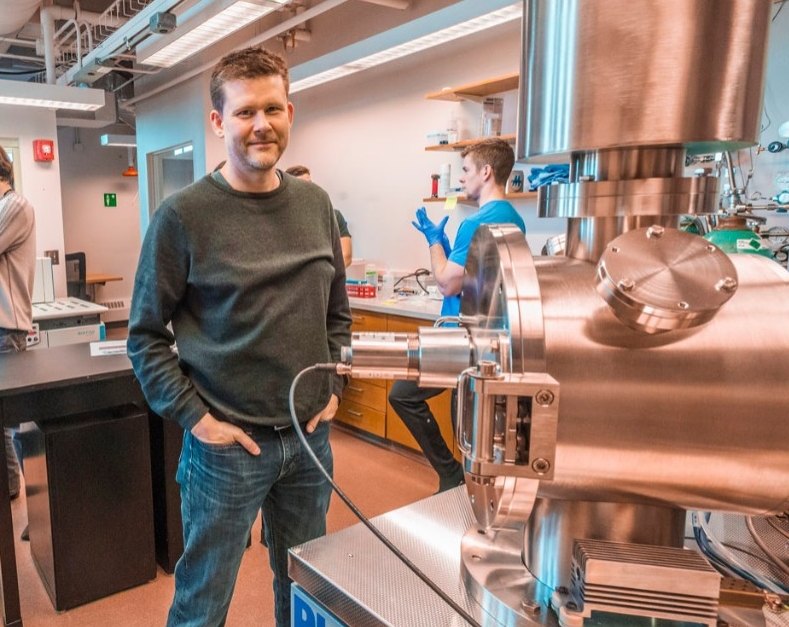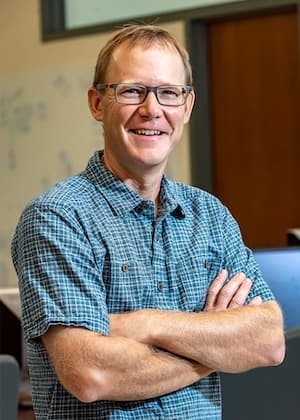The Department of Earth and Environmental Sciences at Boston College will offer a new Ph.D. program that will welcome its first doctoral candidates in the fall of 2020, a move that will further expand the capacity and expertise of the department, according to EES professor and chairman Ethan Baxter.
The doctoral program was approved by the University's Board of Trustees in June and recruitment of the first cohort of approximately five Ph.D. candidates is underway, Baxter said. Between the existing EES master’s degree program and the new doctoral program, Baxter said, the department anticipates its total number of graduate students will ultimately be about 21, with approximately 15 doctoral students.

EES Professor and Chair Ethan Baxter (Gary Wayne Gilbert)
“It was just the right time for Earth and Environmental Sciences to launch our doctoral program,” said Baxter. “We have world-renowned faculty who helped to establish BC’s excellence in the geosciences. We’ve grown through many exciting faculty hires in the past few years, along with strategic improvements in our laboratory facilities. Our doctoral students will find a department with broad capacity to develop them as leading-edge scholars of the Earth and its environment.”
Baxter said the program will focus on three interrelated sub-disciplines at the center of faculty expertise: environmental and climate change, tectonics and dynamics of the Earth’s interior, and water throughout the Earth system. The doctoral program will support a deeper exploration of the ways in which these areas intersect and interact, including interwoven human dimensions.
The addition of doctoral students will also continue to expand the capacity of the department in areas of research, sponsored funding, classroom teaching, and mentoring.
“We can do so much more for BC undergraduates as we grow this new doctoral program,” Baxter said. “It will help us develop richer, deeper, and more sophisticated opportunities in the lab and in the field. Having Ph.D. students here teaching labs, leading complex discussions, and serving as mentors adds a whole new tier to the student experience in Earth and Environmental Sciences.”
EES has approximately 50-60 majors, as well as 50-60 additional students in the Environmental Studies program, an interdisciplinary major that the department supports. There are currently approximately 15 students pursuing master’s degrees.

Associate Professor and director of graduate studies Mark Behn (Lee Pellegrini)
Associate Professor Mark Behn, who directs graduate studies for the department, said the overall number of graduate students will grow modestly, but Ph.D. students will ultimately make up a majority of the graduate student ranks.
Many of the master’s students in the EES program have been going on to doctoral programs all around the country, Behn said. “The new program gives students the opportunity to come here for the Ph.D. track, and gives our master’s degree students the chance to continue if they decide a Ph.D. is what they want. The goal is to accommodate both tracks toward a Ph.D.”
The geological sciences have embodied an interdisciplinary approach for years, said Baxter. Department faculty possess expertise often at the intersection of geology, chemistry, physics, and marine biogeochemistry, and have also been at the forefront of the renewal of BC’s Core Curriculum, developing co-taught courses with colleagues from disciplines such as history, sociology, philosophy, theology, and art history.
That commitment to an interdisciplinary approach will take on added dimensions when the Schiller Institute for Integrated Science and Society opens in the fall of 2021. With its emphasis on finding solutions to problems in public health, energy, and the environment, Baxter said department faculty are poised to make significant contributions to the institute’s research and educational agenda.
“Our ability to be at the forefront of research and leadership in complex earth and environmental science issues—be it at Schiller or within our discipline—is enhanced by the Ph.D.-level science taking place,” he said.
The addition of doctoral students will help support the work of faculty labs, as they do in the departments of biology, chemistry, and physics. In recent years, the University has invested approximately $3 million in department facilities, including a new clean lab, mass spectrometry lab, scanning electron microscopy lab, computational resources, and office improvements.
Doctoral candidates will expand the department’s capacity to produce more impactful research, which Baxter said will support grant writing and lead to even more research sponsored by government agencies, such as the National Science Foundation, where the department gets most of its external funding. The presence of doctoral students also aids in new faculty recruitment.
“This is a really exciting time for the department, what with a number of new faculty, a Ph.D. program coming on line, and the Schiller Institute under construction,” said Behn. “There is going to be a lot of activity and a lot of excitement taking place in Earth and Environmental Sciences in the years to come.”
Ed Hayward | University Communications | September 2019




%201070.jpg)